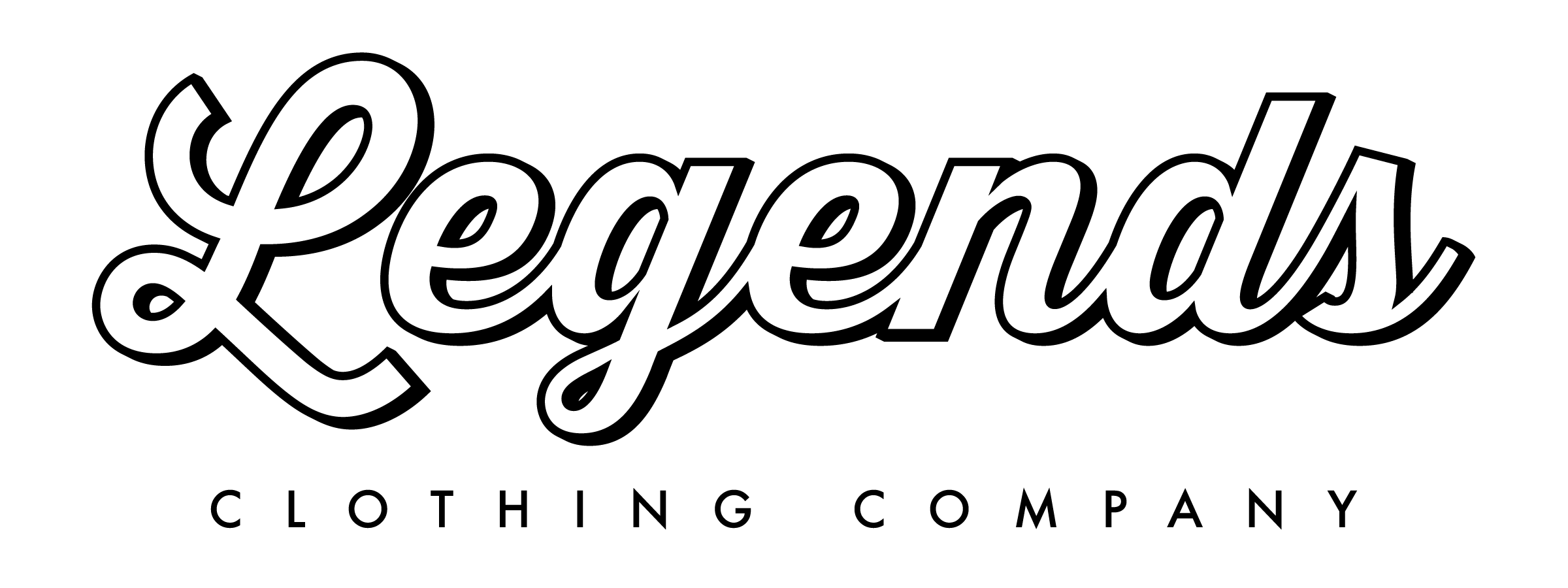
Intimidation involves intentional actions that would make an ordinary person fear injury or harm. These teams went beyond that, exhibiting behavior even their peers found troubling. Whether through fighting, drug use, appearance, unpredictability, dominance, aggression, or the potential for injury, these teams instilled a notable level of fear in their opponents. They pushed boundaries, influencing the rules in their respective sports. It's worth noting, no one is intimidated by a losing team.
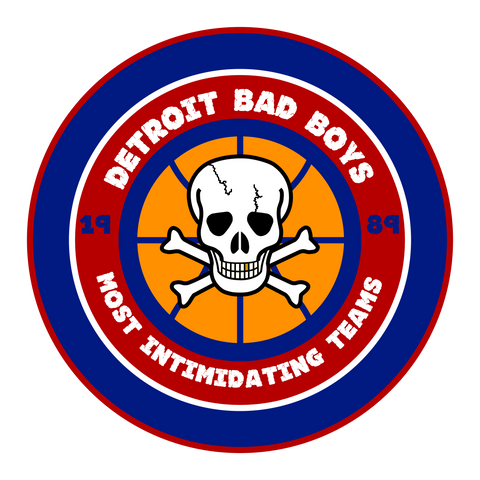
Detroit Bad Boys 1989
Who? Isiah Thomas, Dennis Rodman, Bill Laimbeer, Rick Mahorn, Chuck Dailey
Why? Strong Language, Violence, Gore, Grisly Images, Torture, Aggression, Psychological Games, Trash Talk, Jordan Rules, Injury Potential
Have you ever heard the expression “pick on someone your own size”? This concept was mastered by the 1989 Detroit Pistons, who loved a good brawl. They played the game of basketball like escaped convicts imploring physical and mental intimidation. The Bad Boys were the most violent team, in the history of basketball. Renown for their cheap shots and no layups allowed attitude.
Led by Dr. Jekyll himself, Isiah Thomas smiled in your face and stabbed you in the back. Rick Mahorn, Dennis Rodman and Bill Laimbeer formed a nasty front court, that could get into the heads of even the best front court players. Bill Laimbeer was a renown cheap shot artist, perhaps his finest moments came in the 1990 NBA Finals, when he frustrated Portland's big men to the point of tears. Chuck Daily also known as “Daddy Rich," kept the pack relatively under control, as the head coach.
Detroit held a rare trait, the best players in the world were terrified of playing them. While their physical play was highly publicized, the mental games they played with opponents had devastating effects. There no layup rule often left stars like Michael Jordan, Larry Bird, Dominique Wilkins, Charles Barkley and Magic Johnson bloodied on the floor. Each of these star players saw their field goal percentage drop significantly when playing Detroit. When these stars played Detroit in the playoffs their FG% dropped even further.
Of course their was no shortage of fights on court. Among their best fights could have been the numerous assaults on Boston’s McHale and Bird. The two teams had bench clearing brawls more than 8 times. Perhaps their most famous battle was that with Michael Jordan. The “Jordan Rules” was a strategy employed by the Pistons that called for 3 players to rush the paint anytime Michael took a dribble. They're reasoning was simple “Michael didn’t trust his teammates and we knew that” said longtime Piston Bill Laimbeer. The strategy worked as Detroit beat Chicago in three straight playoff series. For a longer list of their most famous fights and plays check out the video here.
Technical fouls were not called nearly as much as they are now. With that being said, the Pistons still had their fair share of technical fouls. In fact from 1986-1990 the Pistons ranked first in average technical fouls per game. A recent article has even suggested that The Bad Boys had the largest number of technicals, relative to the league average in NBA history.
The most intimidating part of it all was the back to back championship banners they hung in 1989 and 1990. The 89 season saw Detroit finish the regular season with a 63-19 record. They had the second best playoff record of all time, loosing only two games in the playoffs. While it was great to watch the physical style employed, it also led to the cotton candy style of play that dominates today.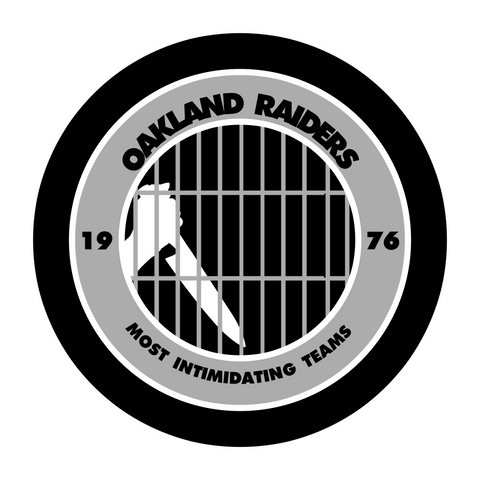
Oakland Raiders 1976
Who? Jack Tatum, John Madden, Otis Sistrunk, Ken Stabler, Willie Brown, Skip Thomas, Dave Casper, Phil Villapiano, Ted Hendricks, Fred Biletnikoff, Cliff Branch
Why? Cocaine Use, Substance Abuse, Steroid Use, Strong Language, Violence, Gore, Grisly Images, Gang Affiliated, Torture, Illegal Equipment, Some Nudity, Aggression, Psychological Games, Injury Potential, Frightening Appearance
“I like to believe that my best hits border on felonious assault.” These words spoken by Safety Jack Tatum summarized the 1977 Raiders. True bullies on the defensive end of the field. Their revolutionary press style and blind side hits were innovating. Opposing rival coach Chuck Knoll once commented that “They were the criminal element of the league”. Rumors of drug use on and off the field were more than speculation. Perhaps their biggest accomplishment was their ability to bend the rules.
The 1977s Raiders featured some of the most feared defensive backs in NFL history. Nicknamed “The Soul Patrol”, they featured Jack “The Assassin” Tatum, Skip “Dr Death” Thomas, Willie Brown, and George Atkinson. Tatum was known around the league as the most devastating hitter, having knocked out over 30 players throughout his pro career. Several Tatum stories have become NFL legend. He and Earl Campbell collided head on, both were knocked out on impact. Famously his hit paralyzed wide receiver Darryl Stingley and he separated Vikings receiver Sammy White from his uniform. The rest of the defense backs were plenty intimidating. In 1976 defensive back George Atkinson knocked out receiver Lynn Swann with a forearm to the back of the head. Skip Thomas earned his Dr. Death nickname with his aggressive play. Mad men like Ted Hendricks, Phil Vilapiano and Otis Sistrunk rounded out the 11 angry men.
On the opposite side of the ball, the offense showed they were for real. Art Shell and Gene Upshaw formed the greatest lineman combo in NFL history. Kenny Stabler was amongst the best quarterbacks in the league and might have been the toughest. Cliff Branch brought a deep threat that was unmatched by others in the time period. Dave Casper gave Stabler a big physical tight end that could both block and catch. Mr. Stick-em Fred Belitnoff was acted as the intermediate threat. Casper & Branch were both named first team all-pro.
The Raiders intangibles were absolutely off the charts. What do I mean by intangibles? They were the first to employ themes like “Rule 1, Cheating in encouraged, rule 2, see rule number one. Another piece of the Raiders bad boy image, were the ridiculous pads and accessories they used to their advantage. Full casts were hardened and applied, so the players could use them as club-like weapons on the field. Illegal spike cleats, extra layers of padding, stick-em, anything they thought would give them an edge was used.
Several after hours stories about this bunch have been told throughout the years. Notably Anthony Kiedis Autobiography Under the Bridge, Kiedis claimed to have sold a good amount of cocaine to more than 5 members of the 1977 Raiders team. Did I mention Kiedis was 12 and he sold it to them the night before the Superbowl? Their has been additional stories linking team members to the Hells Angels Biker gang.
Aside from their off the field shenanigans, the Raiders were truly a dominant team. They posted a regular season record of 13-1, first in the AFC west. They went on to beat New England in the divisional round of the playoffs, before beating their rival Pittsburgh Steelers 24-7 in the Conference championship. In Super Bowl XI they dominated Minnesota to the tune of 32-14. During their playoff run, they outscored opponents 80 to 42. 
New York Mets 1986
Who? Doc Gooden, Darryl Strawberry, Keith Hernandez, Lenny Dykstra, Bobby Ojeda, Wally Backman, Joe Carter, Kevin Mitchell, Ron Darling
Why? Cocaine Use, Substance Abuse, Strong Language, Violence, Gore, Grisly Images, Some Nudity, Aggression, Psychological Games
The cocaine circus on wheels, that was the 1986 world champion New York Mets. As pitcher Bobby Ojeda said in his book, The Bad Guys Won, “We were a bunch of vile fuckers.” With guys like Darryl Strawberry, Dwight Gooden and Keith Hernandez the 86 squad could be seen as the “kings of nose candy”. Guys like Lenny Dysktra, Bobby Ojeda, Wally Backman, Kevin Mitchell, Joe Carter and Ron Darling all contributed to the madness. The turning point of the season for the Mets, came on May 27 when third baseman Ray Knight brawled with Dodgers' pitcher Tom Niedenfuer. Summed up the Mets were a gang of drunks, pill-poppers, barroom brawlers, degenerate gamblers, cocaine enthusiasts, womanizers, and all-world egos that won the hearts of New Yorkers.
After clinching the league championship with a 15 inning game in Houston, the Mets boarded a flight back to New York. Most of the players felt the same way, lets get on this plane and absolutely tear it apart. This included players hovering fat rails of cocaine in the bathroom, harassing the flight attendants, and racking up $7,500 in damages to the plane. Backup catcher Ed Hearn recalls “Soon steaks were flying like Frisbees. It was the epic carnivore free-for-all. ‘By the time we reached the airport, guys were eating the steaks raw,’ says Hearn. ‘Taking bites out and breathing hard and hitting each other. It was that psycho mentality.’”
The most dominant and out of control player on the team was 21 year old ace Dwight “Doc” Gooden. After winning the Cy Young the previous year Gooden continued to pitch well to the tune of a 17-6 record and a 2.84 ERA. The only problem was Gooden was massively addicted to cocaine, so much so, he missed his teams championship parade. Gooden himself said “I end up leaving the party with the team, going to these projects, of all places in Long Island.” I got time.’ And the clocks, I mean the rooms are spinning. I said, ‘OK, I’ll leave in another hour.’ Then the next thing you know the parade’s on and I’m watching the parade on TV.
With 5 All-Stars, their collection of pitching was the best in major league baseball. Dwight Gooden, Bobby Ojeda and Ron Darling formed a starting rotation that was second to none. Between the trio, they won 50 games with a 2.73 ERA. Their Bulletin might have been better featuring Jesse Orosco, Randy Myers and Randy Niemann.
Daryl Strawberry was a phenomenal 24 year old prospect, batting .257 to go with a team leading 27 home runs and 93 RBIs. The night before the now-famous 1986 Game 6, Strawberry lost control. He nailed his wife in the face, breaking her nose. The bloody image of Strawberry’s domestic dispute would define him for the next decade. After the 1986 championship things started to spin out of control, he was charged with beating his fiancé in 1990 and his girlfriend in 1993.
Keith Hernandez and Lenny Dykstra were both big contributors offensively. Hernandez hit .310 with 83 RBIs and an on base percentage of .413. Dykstra hit .295 with a team leading 31 stolen bases. Both players were named All-Star’s during the 86 campaign. Unfortunately both players were stained, after being named in the Pittsburgh Drug Trials in 1985. Baseball commissioner Peter Ueberroth ruled that Hernandez was among 7 players who had used cocaine and been involved with distribution. Both Hernandez and Dystra were able to have tremendous seasons in 1986 after rebounding from their season long suspensions in 1985.
They finished the season with 103 wins most in the national league. During the world series everything turned around in game 6 when a ground ball went through Redsox first basemen's Bill Buckner’s legs. After that the Mets were able to rally for a game 6 win and then easily won game 7. Doc Gooden best summed up the win “But in the early craziness of the locker room, two thoughts were crowding all the others out of my head: I gotta call my dealer. And I gotta call my dad.”

Pittsburgh Steelers 1978
Who? Mel Blount, Jack Lambeer, Jack Ham, Mean Joe Green, Lc Greenwood, Terry Bradshaw, Franco Harris, Lynn Swann, Mike Webster
Why? Substance Abuse, Strong Language, Violence, Grisly Images, Aggression, Psychological Games, Injury Potential, Frightening Appearance
The famed “steel curtain” dominated the NFL in the 1970s, winning 4 Superbowl's. Loaded with 7 defensive hall of famers, players like Jack Lambert, Mean Joe Green, LC Greenwood, Jack Ham and Mel Blount. They lost 2 games by a grand total of 10 points all year (both teams would reach the championship game in their respected conference). The 1978 season would mark their third championship in the 1970s. To understand the measure of respect Pittsburgh demanded at the time, the Steelers had 12 players named as All Pros at their respective positions. Some ague that the Pittsburgh teams of the early 1970s were a better defense, but this team was by far the most well rounded.
The Steelers teams of the 1970s were stacked with intimidating defenders like “Mean” Joe Green, Lc Greenwood, Mel Blount, Jack Ham and Jack Lambert. Eight of the defense’s starting 11 players were elected to the Hall of Fame. No team will have a defense with more hall of famers at one time. The 78 team was able to finish the season with the second most forced turnovers in the league.
Mel Blount was among the most intimidating defense backs of all time. In fact because of Blount’s legendary press converge the NFL was forced to change their rules, in turn the 5 yard contact rule is also known as the Mel Blount Rule. Joe Green was a devastation force that ranked among the most dominant lineman of his time. He was a perennial contender for the defensive player of the year award. Jack Ham and Jack Lambert were the rugged hitting linebackers that anchorched the defensive unit.
The offense was led by Terry Bradshaw, Len Swann, John Stallworth, Franco Harris and Mike Webster. Nothing scares a defense quite long the long pass, the Steelers tormented secondaries with their air attack. Bradshaw put together the best year of his career to that point, becoming only the second Steeler to win the NFL MVP award. Bradshaw posted career highs (to date) in completions (207), attempts (368), passing yards (2,915), touchdowns (28) and quarterback rating (84.7). Len Swann both had a career year catching 11 touchdowns to go with 880 yards receiving. Deep threat John Stallworth caught 9 touchdowns to go with 800 yards receiving.
The playoff run began with a domination of the Denver Broncos 33-10. In the AFC championship game, they embarrassed the Houston Oilers to a tune of 34-5, with Pittsburgh forcing 9 turnovers. The Steelers then finished off their storybook season with a win over the Dallas Cowboys in Super Bowl XIII. In what is still considered one of the greatest Super Bowls ever played. Terry Bradshaw took home MVP honors in Miami, as he threw for over 300 yards and four TDs.
Oakland Athletics 1989
Who? Mark McGwire, Jose Canseco, Dave Stewart, Dennis Eckersley, Tony La Russa
Why? Cocaine Use, Substance Abuse, Steroid Use, Strong Language, Violence, Cheating, Aggression, Power, Frightening Appearance
The 89 Athletics were the George Washington of Steroids, leading the way for future generations. “The Juice Crew” were the bros of your nightmares, fueled by steroids and success. This team was an all time great power hitting lineup, most of which powered by steroids. Rumors swirled of drug use and fights in the Oakland clubhouse, mainly between the young regime and the old veterans. The crew also had a signature handshake that featured forearm bumps instead of fists bumps.
Oakland boasted some of the best power hitters in the game like Mark McGwire, Dave Henderson, Dave Parker and Jose Canseco. They didn’t just hit regular home runs, these were moon shots. Blasts like Canseco's and McGwire's famous home runs to the third deck of Toronto's Skydome (both blasts went over 520 feet). They also featured the speedy leadoff man Ricky Henderson. Add Dennis Eckersley to the bunch, one of the most feared closers of all time. The bay area native posted a 1.56 ERA and led the league in saves with 33. The collection of ego’s and personalities might be enough to intimidate any team. Throw in passive aggressive steroid behavior and you have a frightening team.
Canseco suffered a wrist injury before the season and didn’t return until after the All-Star break. Dave Parker filled some of the power void and hit 22 home runs and finished with 97 RBI. And when Canseco did come back, he hit 17 home runs in less than a half-season of play. The sensational Mark McGwire hit 33 home runs to lead the team.
Oakland was able to finish the season first in their division, with 99 wins. They defeated the Toronto Blue Jays in five games in the ALCS. Then swept their cross-Bay rivals, the San Francisco Giants, in an earthquake-marred World Series. They only lost one game in postseason play putting them near the top of all time dominating post seasons.
When Jose Canseco’s book Juiced was published in 2005, many of the A’s stories would come to limelight. Canseco claims that he introduced Mark McGwire to steroids in 1988 and that he often injected McGwire while they were teammates. He also admits that he envisions himself as the godfather of steroids to the entire MLB.
While they haven't played together for more than 25 years, a reunion seems unspeakable. Former teammate Carney Lansford was quoted as saying if Canseco were coming to the reunion, "I don't believe there's a guy on the '89 team who'd show up. Not after his book and all the lives he ruined. It's selfishness, basically. I hate to say that, really. I played with him and thought he was a nice guy, but I don't know how you can do that to people."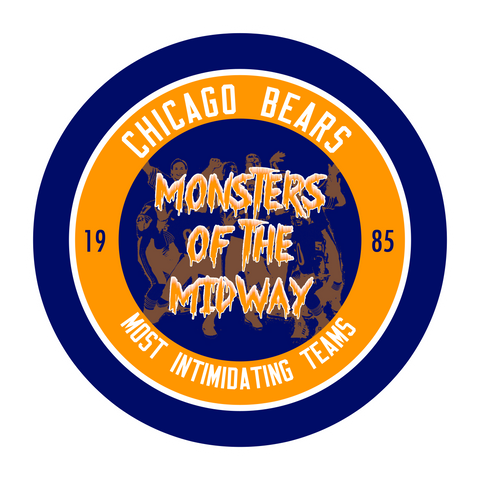
Chicago Bears 1985
Who? Mike Ditka, Mike Singletary, Otis Wilson, Buddy Ryan, Walter Payton, Jim McMahon, Dan Hampton, Richard Dent, Buddy Ryan
Why? Substance Abuse, Strong Language, Violence, Gore, Grisly Images, Some Nudity, Aggression, Psychological Games, Injury Potential, Frightening Appearance
The Monsters of the Midway could make an argument for the greatest overall team of all time. This team didn’t need sideshows or gimmicks to intimidate their opponents, they flat dominated them. Probably the only team on the list that didn’t feature the most menacing player, a group of fighters, or even the biggest group of partiers. This collection of talent was most imposing during the actual game. They embarrassed almost every pro offense they faced and as a result the defensive side of the ball was never the same. NFL network named them the best defensive unit of all time.
They went 15-1 during the regular season, their lone loss came at the hands of Dan Marino’s Miami dolphins. In the playoffs they laughed teams off the field, outscoring opponents 91 to 10. During the entire season Chicago was only involved in three games decided by 7 or less.
The 85 defense was simply the greatest defense of all time. Imploring the physical strategy of the 4-6 defense, Chicago was the most feared defense of their time. They had a bevy of tremendous players like Mike Singletary, The Fridge, Otis Wilson, Mongo McMichael, Dan Hampton and Richard Dent. The master mind of it all was of course an intimidator himself, Buddy Ryan. The Bears' iconic 46 defense (Named after former Bears' safety, Doug Plank), led by Defensive genius Buddy Ryan, was an "attack from all angles" scheme that resulted in many injured quarterbacks. With future Hall of Famer Mike Singletary alongside the supremely athletic Wilber Marshall and Otis Wilson, the linebacking unit ranked in at #5 of the greatest linebacking corps in NFL history in NFL Top 10. The secondary was anchored by safeties Gary Fencik and Dave Duerson. Their defensive line included future Hall of Famers Richard Dent and Dan "Danimal" Hampton , along with breakout media superstar rookie, William "The Refrigerator" Perry. The Bears were infamous for getting to the quarterback often and completely disrupting their timing. They hold a bevy of bone crushing defensive highlights, complete with multiple quarterback knockouts.
The offense was no slouch led by Walter “Sweetness” Payton (perhaps the best running back in the game at the time), wild man Jim McMahon and the intimidating coach Mike Ditka. Their offense ranked 2nd in the league in points scored. The real strength of their offensive, was their offensive line. Led by tackle Jimbo Covert and center Jay Hilgenberg, they were able to open huge running holes for Walter Payton. At the end of the season Payton, McMahon, Covert and Hilgenberg were all named to the pro bowl.
In their two playoff games against the New York Giants and Los Angeles Rams, the Bears outscored their opponents 45–0 and became the first team to record back-to-back playoff shutouts. Then, in Super Bowl XX against the New England Patriots, the Bears set several records. Their 36-point margin of victory topped the Raiders 29 points margin put up in Super Bowl XVIII and stood as a record until the 49ers won Super Bowl XXIV. It was the Bears' first NFL World Championship title since 1963.
The 1985 bears changed the game with their hard hitting aggressive 4-6 defense. The 4-6 allowed for their defense to get serious hits on quarterbacks and skill players. The only question is, Why did they only win 1?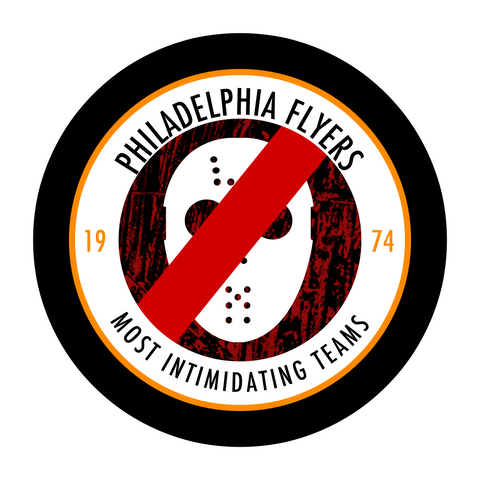
Philadelphia Flyers 1974
Who? Dave Schultz, Bobby Clarke, Serge Bernier, Jim Johnson, Bernie Parent
Why? Strong Language, Violence, Gore, Grisly Images, Torture, Illegal Equipment, Aggression, Psychological Games, Injury Potential, Frightening Appearance, Excessive Blood
They revolutionized the physical style of hockey popular today. Their players refused to wear helmets and led the league in penalty minutes. Their defense specialized in cheap shots and they instigated as many brawls as possible. Opposing teams preparing to play the Flyers knew they were in for a beating. The Broadstreet bullies were as dominant as they were mean, winning back to back Stanley Cup champions in 1974 and 1975. The Flyers were the last Stanley Cup champion to be composed entirely of Canadian-born players.
Early in the 70’s Philadelphia was defeated by the St Louis Blues who employed a more physical style of play than the Flyers. As a result the Flyers brought in bigger and tougher players (also known as bullies). The new additions to the team resulted in a jail house team that routinely broke rules and used fighting to intimidate opponents.
This blood thirsty, ragtag collection of asylum escapees included Bobby Clarke, Serge Bernier, Jim Johnson, Bernie Parent (who wore a menacing Jason mask) and Andre Lacriox. The leader of the asylum was Dave “The Hammer” Schultz. “The Hammer” set the NHL record for penalty minutes in back to back seasons during their Stanley Cup runs. He was best known for his blood filled mustache that often dripped relentlessly. Of course Dave Schultz's 348 penalty minutes led the NFL in 1974.
The 1974 team posted a record of 50-16-12, they won the West by seven points. The outstanding goalie Bernie Parent established an NFL record by winning 47 games, a record which stood for more than 30 years. The Flyers were represented in the All Star Game by Bobby Clarke, Bernie Parent, Ed Van Impe and Joe Watson.
The team was led offensively by Bobby Clarke, who led the team in goals with 35, assists with 52 and points with 87. He finished fifth among scoring leader in points. Clarke was named a 2nd Team All Stars along with defenseman Barry Ashbee. Clarke was followed by Bill Barber in goals (34), and by Rick MacLeish both in assists (45) and in points (77).
Like any intimidating team the Flyers style of play eventually forced the NHL to change its rules. An exhibition game against the Russian team, illustrated the brutality and physicality the Flyers played with. In most peoples eyes this exhibition game forced the NHL to institute new rules to clean up the game.
Pittsburgh Pirates 1979
Who? Willie Stargell, Dave parker, Omar Moreno, Bill Robinson, Bill Madlock, Dock Ellis
Why? Cocaine Use, Substance Abuse, Strong Language, Violence, Illegal Equipment, Aggression, Frightening Appearance, Sledgehammer
They became known as the “We Are Family” team, the Pirates powered their way to the 1979 crown. The Pirates became one of six teams in the 20th century to have won a World Series after trailing three games to one. They beat the Baltimore Orioles in a seven game world series, Willie Stargell took home the MVP. The curricular activities of the Pirates was surely over shadowed by their accomplishments on the field. The world series title was Pittsburgh’s last playoff series victory to date. However many think the Pittsburgh Cocaine trails might have diminished their accomplishments.
The leaders of the team were Willie Stargell and Dave “Cobra” Parker. Both carried heavy reputations as intimidating hitters, as both were amongst the best players in baseball. Parker was the 1978 NL MVP and Stargell took home the award in 1979. Bill Madlock and Bill Robinson both provided instant offensive at the plate.
Willie Stargell got a brilliant idea for their hitters to warm up with sledgehammers. The move intimidated opposing pictures and helped the Pirates confidence. Late in the 1978 season “Cobra” fractured his jaw in a home plate collision. He then wore a hockey-style mask straight from Friday the 13th, to protect his broken cheek bone. The mask was described by some opposing pitchers as terrifying. While the corrective mask was only worn for a short period of time, it made its mark.
The Pittsburgh drug trials shined more light on this collection of talent. Drug use ran rampant throughout the team’s clubhouse. Cocaine was done in record amounts and greenies were popped like skittles in the clubhouse. More than 5 players on the team would eventually be named specifically in the drug trials. Theres no question their drug use contributed to they're intimidating ways. Check out our shirt inspired by the team.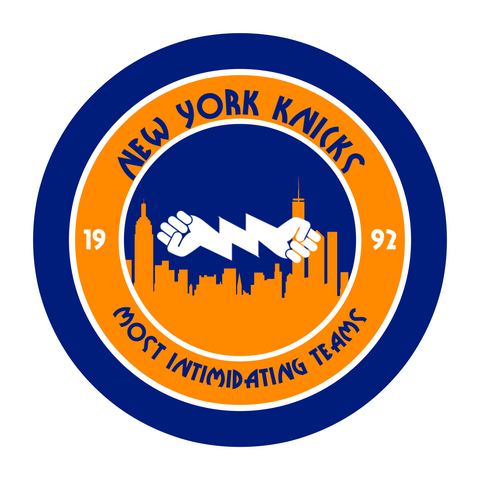
New York Knicks 1992
Who? Anthony Mason, Patrick Ewing, Charles Oakley and Xavier McDaniel, John Starks
Why? Strong Language, Violence, Gore, Grisly Images, Torture, Aggression, Psychological Games, Frightening Appearance, Trash-talk, Injury Potential
The 1992 New York Knicks loved to mix it up on the court. Prior to the season New York hired Pat Riley, signed Anthony Mason and traded for Xavier McDaniel. These additions insured little physical opposition from their opponents. The only team on our list that failed to win the title. New York seemed destined to win a title under the guidance of Pat Riley, who had won five titles in Los Angeles.
The core of New York’s intimidating lineup was formed by their front line. They featured Patrick Ewing, Anthony Mason, Xavier McDaniel and Charles Oakley. A front line which rivaled the Detroit's Bad Boys in terms of physical play and sheer terror. It was unusual for more than 3 games to go by without the Knicks having some sort of fight. Patrick Ewing was widely thought of as the most intimidating player in the NBA. Charles Oakley was a world renown fighter who fought the likes of Charles Barkley, Dennis Rodman, Alonzo Mourning, and Pj Brown among many others. Xavier McDaniel aka “X-Man” was known around the league as a serious fighter. McDaniel would fight you at the drop of a hat, or strangle you if he deemed fit (see Wes Matthews and Juwan Howard). Very few opposing teams chose to challenge prowess of the front line’s fighting ability.
Greg Anthony and Mark Jackson were both among the toughest guards in the league. Jackson had a no-nonsense city game and Anthony once played with a broken jaw for more than a month. The ever unpredictable John Starks also had reputation for being a loose cannon, apparent by the head butt he delivered to Reggie Miller in the 1993 Playoffs.
The team finished second in the Atlantic Division with a 51–31 record. In the first round of the playoffs New York would square off with the 92 version of the Bad Boys Pistons. In a series that closely resembled a cage match, it was the most physical series of all time. During game 1, McDaniel delivered a vicious elbow to Lambieers head resulting in a flagrant foul and a scuffle. In game 2, McDaniel drew a flagrant foul against Laimbeer, before Charles Oakley closed lined Dennis Rodman, both wind up with technicals. In the next game four technical fouls were called in the first three minutes. Rodman then punched McDaniel, resulting in the two tangling up. During the fourth quarter, Darrell Walker earned a flagrant foul for bashing McDaniel, who screamed threats at Walker. All this in the first three games. The Knicks would end up beating Detroit in 5 games.
Next round, the Knicks faced off against the defending champion Chicago Bulls for the second straight year. Bill Laimbeer of the vanquished Detroit Pistons thought the Knicks would strongly compete if they were allowed to play this way, but doubted "the league" would let them. To the contrary, Phil Jackson said of the NBA, "I think they like this style." Several players including, Michael Jordan, Xavier McDaniel, Scottie Pippen and Greg Anthony got into physical altercations. New York was able to frustrate Michael Jordan with their physical play, but ultimately lost to Chicago in 7 games. During the offseason McDaniel left for Boston, New York never took Chicago to seven games again. Many observers think it was the closest any team got to stopping Chicago’s run of 6 championships in the 90’s.
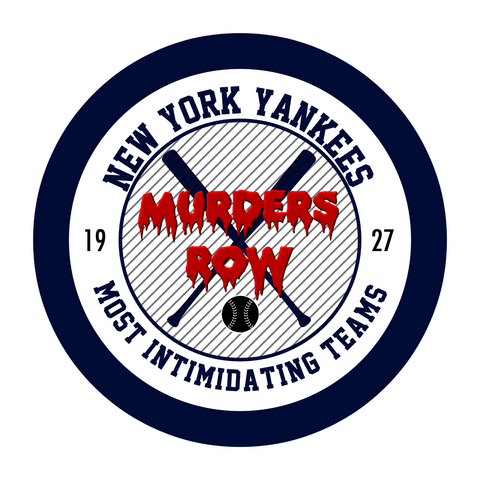
New York Yankees 1927
Who? Babe Ruth, Lou Geriehg, Earle Combs, Tony Lazzeri, Herb Pennock, Waite Hoyt, Miller Huggins
Why? Drinking, Strong Language, Violence, Aggression, Psychological Games
Murder’s Row was the Beatles more than 25 years before the Beatles. They featured seven hall of famers on their roster. The first truly intimidating team in sports, opposing pictures and sports writers were so obsessed with the team, they were nicknamed the Murders Row for the core of they're hitting lineup. Following a 21-1 July victory against the Washington Senators, first basemen Joe Judge said “Those fellows not only beat you but they tear your heart out. I wish the season was over.” Murders Row existed in a time where super teams were more than 50 years away. The 1927 Yankees batted .307, slugged .489, scored 975 runs, and outscored their opponents by a record 376 runs. Did I mention they had the two most feared hitters in the game?
The nickname describes the first six hitters in the 1927 team lineup: Earle Combs, Mark Koenig, Babe Ruth, Lou Gehrig, Bob Meusel, and Tony Lazzeri. Center fielder Earle Combs had a career year, batting .356 with 231 hits, left fielder Bob Meusel batted .337 with 103 RBIs, and second baseman Tony Lazzeri drove in 102 runs. Gehrig batted .373, with 218 hits, 47 home runs, a then record 175 RBIs and was voted A.L. MVP. Ruth amassed a .356 batting average, 164 RBIs, 158 runs scored, walked 137 times, and slugged .772. Most notably, he set the single season home run record with 60.
The two most intimidating hitters in baseball, Babe Ruth and Lou Gehrig, were bitter rivals in the same clubhouse. Their differences in personality created a rift between the superstars. Ruth was an undisciplined man in every facet of his life, except hitting. While Gehrig, was never one for empty boasting. Another factor in their rift was differences in salary between the two. Babe made $80,000 during the height of the Great Depression, Gehrig less than half that amount. The two rivals would duel off in a season long home run contest. Early in the season, the New York World-Telegram anointed Gehrig the favorite. But Ruth caught Gehrig and then had a remarkable last two months of the season, hitting 17 home runs in September. After his 60th, Ruth was exultant, shouting after the game, "Sixty, count 'em, sixty! Let's see some son-of-a-b**** match that!"
They finished the year 110–44 winning the A.L. pennant by 19 games. New York swept the Pittsburgh Pirates in the 1927 World Series. Only four teams have won more regular season games to this date. Unquestionably one of the greatest teams in MLB history.
Hope you enjoyed the list, leave a comment below and tell us what we missed!
